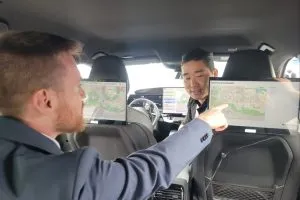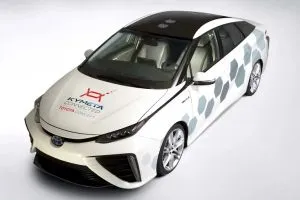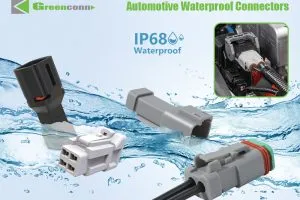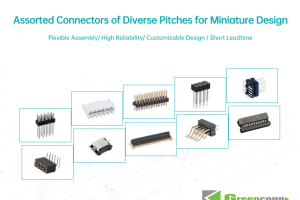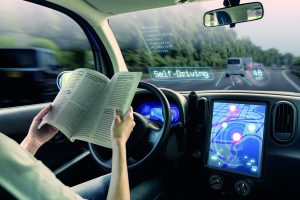
Vehicle-to-Everything (V2X) devices serve as an interface to the digital world and offer the capability to provide software and firmware updates over the air, to offer real-time traffic information to the driver, to serve infotainment and entertainment content on demand and to enable a variety of applications.
Many automated driving functions require accurate position information. For example, global navigation satellite system (GNSS) position correction data is transmitted over cellular networks to increase accuracy for those advanced driver assistance systems (ADAS)/autonomous driving (AD) functions to navigate at lane level through inner cities’ complex street alignments (Figure 1). Data transmitted over V2X communications is considered as additional sensor information and enhances automated driving, making it smoother and more convenient. ADAS/AD is supported to know road geometry in advance, to be informed about traffic situations in real-time, and to consider temporary road closures and changes due to road constructions and other incidents.
Digital services
The industry faces several challenges to implement new digital services, among
those are:
* Data availability and interfaces: Providing traffic-related data should not stop at the boundary of a single automaker, in particular not for safety-related information. Furthermore, the interface used to exchange data needs to be known and recognised in the industry.
* Trust: How do the driver and ADAS/AD functions know that the data provided originated from a trusted source and are not corrupted. How can it be ensured that the information provided by a road side unit about the traffic light status on an intersection is correct after installation? This can lead to one-time tests and potentially certification in R&D process up to field tests in regular intervals.
* Conformance and interoperability: V2X radio devices need to conform with industry standards and regulatory requirements. Verification of interoperability is key to letting road users transmit data, exchange messages and understand the intended information.
* Industry technology agreement: Consensus amongst all stakeholders is necessary. Cellular networks with communication services are omnipresent today. In addition, V2X uses direct communication between road users. It promises to make the system more robust to potential outages of the cellular systems and thus independent of any cellular network operator deployment. This requires an industry agreement to implement and operate direct communications for vehicle-to-vehicle (V2V), to-infrastructure and to-pedestrian communications.
WLAN and Cellular V2X technologies

Figure 1: GNSS position correction data supports navigation functions in busy environments
WLAN targets shorter range communications in the unlicensed spectrum for consumer electronic applications, while cellular technology focuses on radio access for wide range communications in the licensed spectrum.
Both are making steady progress to support new and emerging applications, together with throughput improvements and lower transmission latency. The cellular system provides voice and data services to wide area mobile scenarios. Centralised controlled access to the radio system operated by base stations with cell planning improves interference management and admission control.
A well-established ecosystem built around cellular technologies offers a variety of services and applications ranging from consumer to enterprise businesses, even with private network installations. Cellular technology has supported direct short-range communications for several years, providing an alternative technology to WLAN for V2X communications.
Automakers deploy cellular direct communication devices in China. The US frequency regulation authority FCC is preparing a new rule to permit cellular V2X direct communication.
V2X system design
WLAN and cellular technologies are not interoperable at the radio level. The demand for shorter range communication in the unlicensed spectrum in household and office installation will remain and users will always demand the less complex exchange of data without expensive installation.
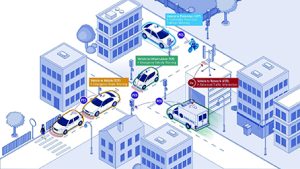
Figure 2: Industry agreement will be required for direct communication
Cellular systems provide communication service to a wide area, allowing for mobile access to internet services. WLAN and cellular technology are expected to compete for dominance in V2X direct communications. Currently, the US and China automotive markets have decided on cellular V2X technology, while the frequency regulation in Europe and other regions allows both WLAN and cellular system technologies to operate direct communication in the ITS 5.9GHZ frequency.
The role of 5G connectivity
ADAS/AD will benefit from additional traffic information provided over 5G connectivity. The continuous updating of high-definition navigation maps is one example of an application that demands higher data throughput. Automated valet parking and tele-operated driving are two use cases that require connectivity service with higher transmission reliability and which are, in part, already being implemented. Providing ubiquitous 5G connectivity with higher performance even in rural areas is challenging. New 6G technology demands the combination of data communication and sensing. Both applications will benefit from frequency ranges newly assigned to mobile communications and sensing purpose. Data transmission will be improved through integrated sensing applications, while radar operation may benefit from interference co-ordination.

Image: Rohde & Schwarz
Generally, autonomous driving will be possible without any radio communication. However, data transmission between road users and further access to external data sources via dedicated infrastructure such as roadside units and via the mobile networks will improve convenience and may make driving even safer.
Future-proof and interoperable V2X systems
Unquestionably, the average lifetime of vehicles, which exceeds 10 years on average, is another challenge to the ecosystem. A variety of mobile technology generations is expected to be deployed and operated in the market, with the same technology used with releases being backwards-compatible. Going to a new technology for example, 4G to 5G and in future 6G, requires additional solutions to remain compatible. Having all technology generation integrated is a straightforward approach, which is also used in smartphone devices, but nevertheless, a migration path needs to be in place.
 Electronics Weekly
Electronics Weekly
